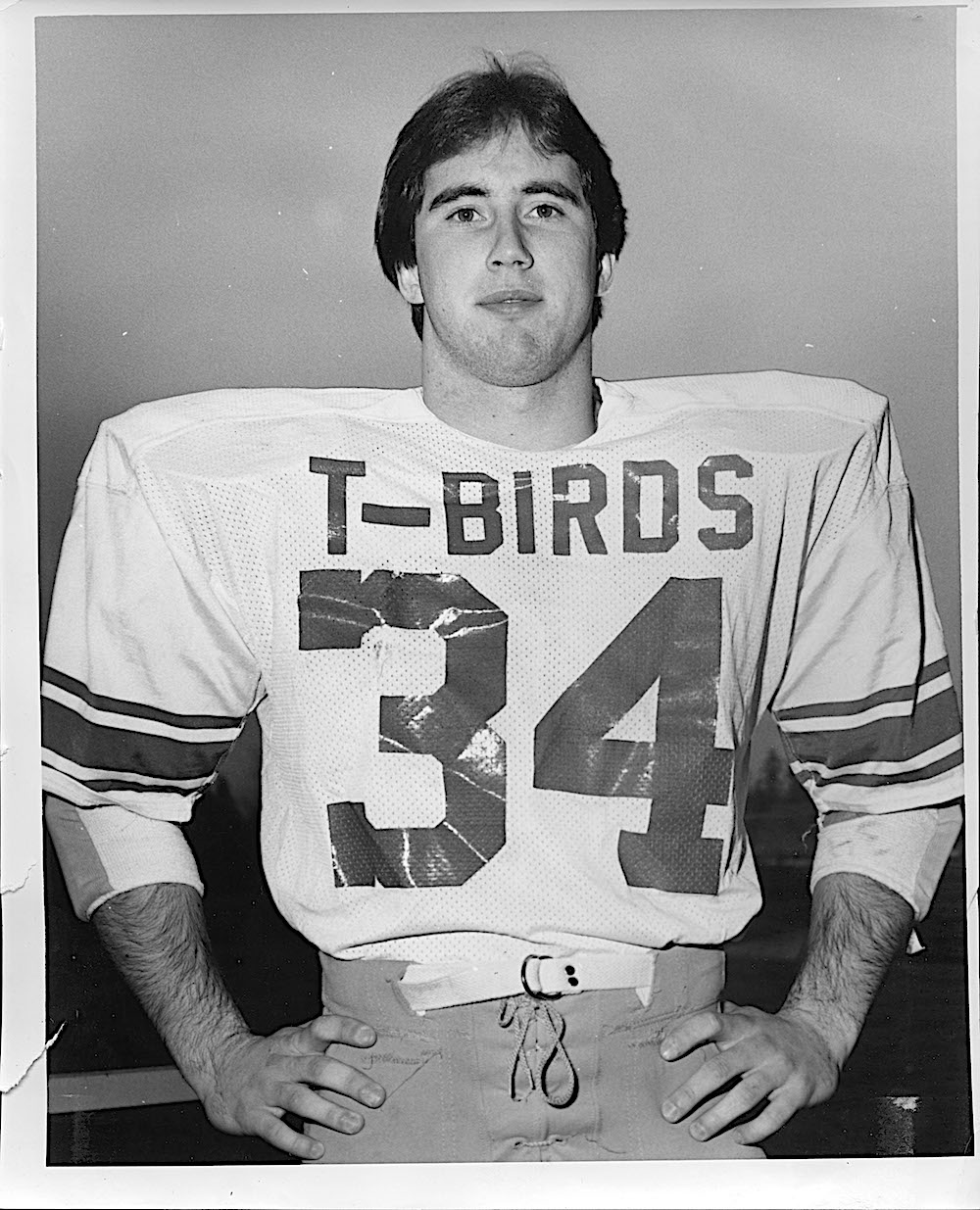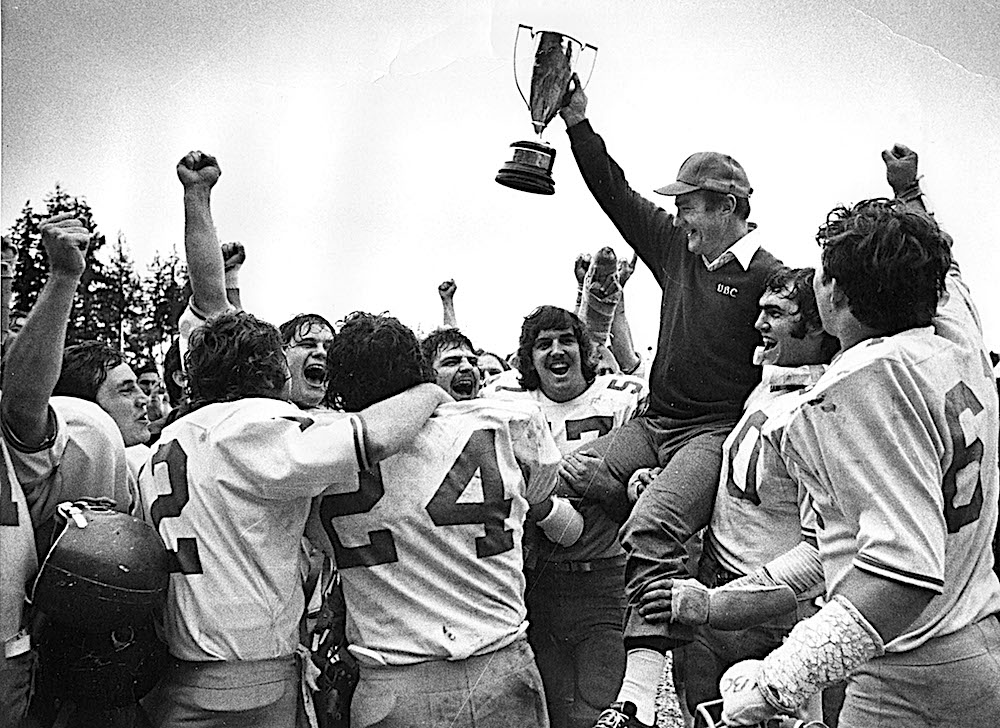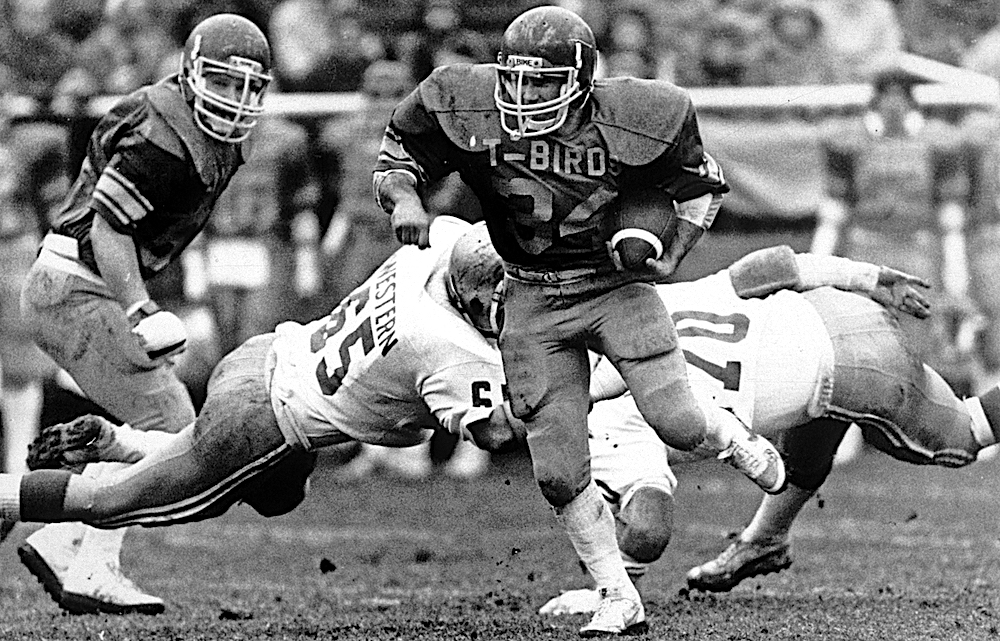VANCOUVER — The greatest player in the history of UBC Thunderbirds football is asked to remember his favourite moment from the game which propelled his team into the 1982 Vanier Cup national final.
All these years later, Glenn Steele remains the ever-humble ‘Bird, yet even his best attempt at a simple recollection winds up sounding a bit like a fairy tale.
And that’s because when he tucked a football under his arm and engaged his vision up the field, a kid from a mid-1970s working class East Vancouver neighbourhood suddenly became equal parts Peter Pan and The Flash.
Today, one sleep before the opening of UBC’s 2017 home campaign, we cap a glorious countdown of The Top 100 UBC Football Players by saluting No. 1, running back Glenn Steele, whose feats on the gridiron over a brilliant four-year career in blue-and-gold did everything to suggest that nothing was impossible.

THE MAN OF STEELE
Our story begins with a story, the moment Steele most remembers from the Atlantic Bowl national semifinal played on Nov. 13, 1982 against St. Francis Xavier at Huskies Stadium in Halifax.
“We ran this one toss sweep, called 26 Toss,” begins Steele. “I can still remember that I just followed (offensive lineman) Pieter Vanden Bos. It was like it was happening in slow motion. I waited and I waited, and then I just exploded. It was 50-or-60 yards for the touchdown.”
Perhaps at no other moment during its memorable run to the national championship under head coach Frank Smith was the flex of its collective muscle so taut and so deadly.
Steele, just 19 years old and less than two full seasons removed from high school glory with the Notre Dame Jugglers, would go on to rush for 276 yards and four touchdowns that day.
“At UBC, we played all of our games on grass, but this one was on Astro-Turf,” Steele says during a lengthy phone interview from his home in the Los Angeles area where he works as a VP of National Sales for Coca-Cola.
“All of my games in high school at Notre Dame were on turf (Empire Stadium) and I always felt that when you were, you were always a little quicker.”
It was a portent to a fairy-tale day.
When Steele followed Vanden Bos, then ignited his after-burners for the end zone, the following week’s national championship game almost seemed like it was theirs to lose.
“That was the moment where it all came together,” continued Steele, who in 1982 wore No. 34 and was listed at 5-foot-9 and 180 pounds. “The offensive line (including the likes of Vanden Bos, Jerry Dobrovolny, Don Adamic and George Piva) executed flawlessly, the defence was simply phenomenal, and the way we executed in the first and second quarters just told us how close we were getting to the Vanier Cup.”
In a season of perfection, how close to it were Steele and the ‘Birds that day?
UBC won the game 54-1, and of Steele’s 276 rushing yards, 259 of them came in the first half.
The next week, UBC won the Vanier Cup with a 39-14 win over Western in Toronto where Steele rushed for 236 yards and two touchdowns.
The very next weekend, under Canadian rules at Empire Stadium, UBC beat SFU 19-8 in Shrum Bowl X.
Over the course of that season, Steele led the nation in rushing, set six UBC records, was named the WIFL (Canada West) MVP and the MVP of both the national semifinal final and Vanier Cup games.
Stats are not available from two of the games he played that season. Yet even without knowing his totals against Eastern Washington and Simon Fraser, he carried 183 times for 1,289 yards and 15 touchdowns.
On several occasions, with UBC building huge first-half leads, he would sit out the second half.
With all of that in mind, his 1982 campaign is considered, across all sports, one of the most dominant in UBC history.
And in the big picture, 32 full seasons after his departure from the Point Grey campus, he remains the UBC career record-holder for rushing yards (4,335), rushing touchdowns (36), and overall touchdowns (37).
ARRIVING BEFORE HIS TIME
In the summer of 1976, one year before he would assume the head coaching duties of the senior varsity at East Van’s Notre Dame Regional Secondary, George Oswald remembers seeing a running back whose uncanny natural feel and vision was complimented with a burst of speed that seemed stolen from the gods.
“It was summer training and the junior varsity team needed someone to scrimmage against,” says Oswald. “So they ended up playing against the (soon-to-be) Grade 8 team. This was about two weeks into training. Even by that stage, when he was only in Grade 8, Glenn just ran right through their entire team. They simply could not handle him. I think that should give you some kind of an idea of how good he was.”
By the time he reached his senior season in the fall of 1980 with the dynastic high school Jugglers, Steele had become something of a force of nature.
Notre Dame’s offensive line, whose efficiency in executing off-tackle power runs operated with the precision of a well-oiled bulldozer, consistently created a crease for Steele and it was all he needed.
In fact the essence of his game, and perhaps the essence of UBC’s greatest-ever football team, could be boiled down to the split second in which the East Van kid burst into a hole, planted a foot, and then burst to daylight.
“Was I a pounding runner?” asked Steele. “No. I was not a huge guy. In my mind, it was my quickness. My burst and agility. My mindset was to get to the hole as fast as I could and explode. I always remember what Coach Smith would tell me, that I was an instinctive runner and that if I ever started to over think things, that we’d have a problem.”
Adds teammate Dave Sidoo, who played in the defensive secondary on that 1982 national championship team: “The first four or five steps were so incredible and he hit the hole faster than anyone I ever saw. It looked like he was running scared. Glenn was so explosive and he had all of the star power. Yet he was so humble.”

THE POWER OF TEAM
Just how do you react to being selected the greatest football player in the entire history of one of the most time-honoured programs in the entire nation?
“Honestly, it’s tough to digest,” said Steele. “When you start to think of how many great players there have been and what they mean to you, you get a better idea of what kind of incredible honour this actually is.
“When Coach Smith was recruiting me, I can remember hearing from many people about how that moment in time, when you’re in university and you’re 18-to-22, that it’s the best time of your life.
“You don’t realize it at the time, but then you fast forward 35 years and suddenly I see some of the most memorable moments of my life.”
The long-and-winding road has these days led Steele, 54, to an executive’s life in Los Angeles.
Following two years in the CFL with Winnipeg and Ottawa, Steele returned to the UBC campus in 1987 as an assistant coach under Smith, while also serving as the school’s Sports Information Officer.
At that time, UBC had developed a relationship with Coca-Cola and one day Rick Noonan, then the school’s athletic director, told Steele that the beverage giant was interviewing candidates to work at its offices in Vancouver.
Steele followed up, rose through the ranks and in 1998, when Coke consolidated its western headquarters in L.A., Steele ventured south of the border. He and his wife Colleen, a Delta native, reside in Redondo Beach, a 40-minute drive from the city.
In Steele’s mind, the process of becoming national champions at UBC set in motion a blueprint for he and so many of his teammates that has lasted throughout their professional lives.
“With Coach Smith, we had this almost burning desire to succeed,” he says. “I’d love to mention every player I played with, but especially on that 1982 team. You look back and you see a theme of success, and also, success outside of football. Coach Smith helped us all develop that.”
Steele also credits his early years under the helm of Oswald as key in his development.
“There was an exceptional group coming out of Notre Dame (in the high school grad year of 1981),” remembers Steele, who made the jump to UBC along with fellow Jugglers like Rob Ros and K.C. Steele (no relation), and I think there was an expectation coming from that program that we would carry the same culture and commitment to winning at UBC.”
Oswald, in fact, remembers Steele’s earliest days working for Coca-Cola, including the day he approached his old high school coach and asked him if Notre Dame would consider switching its soft drink allegiance.
“I remember he tried to sell Coke to me one day at the school,” begins Oswald with a laugh. “But we were a Pepsi school, and Pepsi had been very good to us for years. So I told him ‘No’. I didn’t switch just because it was Glenn. And the best part was that he understood because he knew what loyalty meant.”
All these years later, with his place in UBC history even more firmly entrenched, Glenn Steele finds his greatest joy in the fact that his appreciation for a formative time in his life just keeps getting stronger with each passing year.
“It takes something like this for you to reflect,” he explains of the honour. “You don’t realize things at the time. You’re just focused on winning.But then you can look back. It was a pretty special time.”
HOW THE TOP 100 WAS PICKED
Patrick Tracey, defensive coordinator for the UBC Thunderbirds, devised a formula for calculating the “Top 100 UBC Football Players” in the program’s history.
Players were issued a numerical value for a variety of accomplishments: Winning a Vanier Cup; being named a Conference All-Star (Canada West); being named an All-Canadian; leading the team, conference or nation in particular statistical categories; setting UBC records in particular statistical categories; winning or being nominated for school, conference or national honours (i.e. Bobby Gaul Trophy for UBC Most Outstanding Male Athletes, Canada West Rookie of the Year, Hec Crighton trophy); being drafted into the CFL or signing an NFL contract.
These points were then added up to determine a list of the Top 100 players.
If you’re reading this story on any other website other than one belonging to a university athletic department, it has been taken without appropriate permission. In these challenging times, true journalism will survive only through your dedicated support and loyalty. VarsityLetters.ca and all of its exclusive content has been created to serve B.C.’s high school and university sports community with hard work, integrity and respect. Feel free to drop us a line any time at varsitylettersbc@gmail.com.


